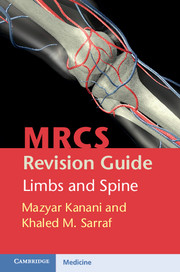Appendix: Additional high-yield topics for the MRCS
Published online by Cambridge University Press: 05 August 2015
Summary
Further to the use of the chapters in this book as an aid for question-and-answer scenarios and practice with colleagues, here are a few more scenarios that may not be covered fully in independent chapters, which might be useful for consideration prior to the examination.
Surgical skills and patient safety
• Hand washing,
• Scrubbing for theatre and de-gowning,
• Insertion of urinary catheter,
• Intravenous cannulation, central venous pressure line (CVP) insertion, chest tube insertion, cricothyroidotomy: all with advanced trauma life support principles or scenarios,
• Suturing of laceration or excision biopsy of skin lesion (benign or malignant), including knowledge of margins and filling pathology forms,
• Postoperative analgesic ladder,
• Non-accidental injury in children – be aware of the signs.
Communication
• History of joint osteoarthritis – know the classic symptoms.
• History of lower back pain, radiating leg pain – differentiate between lumbar disc prolapse and spinal stenosis.
• History of limb claudication and ischaemia, and relevant investigations.
• Obtain patient consent for a hip or knee replacement as well as for treatment of a neck of femur fracture. Look out for the confused patient who may not be able to retain information or consent to an operation. Emergency procedures are different from elective cases. Consider the need for a mini mental state examination and discussion with family. Appreciate the different types of consent forms and the authority needed to obtain consent on behalf of a patient who lacks capacity.
• Order a theatre list with a selection of patients, including (some of): a child, MRSA-positive patient, elderly patient with a fractured neck of femur, diabetic patient, cardiac patient, patient with dirty wound or abscess. Discuss your reasoning.
• Refer an acutely ill patient to the intensive care unit or medical team. Refer a patient to the coroner. Inform your consultant of a multi-trauma patient (consider open fracture management, blood loss, external fixation, vascular or plastic surgery input, transfer to specialist unit). Be aware of the key information that must be discussed, depending on the scenario.
- Type
- Chapter
- Information
- MRCS Revision Guide: Limbs and Spine , pp. 161 - 162Publisher: Cambridge University PressPrint publication year: 2012

